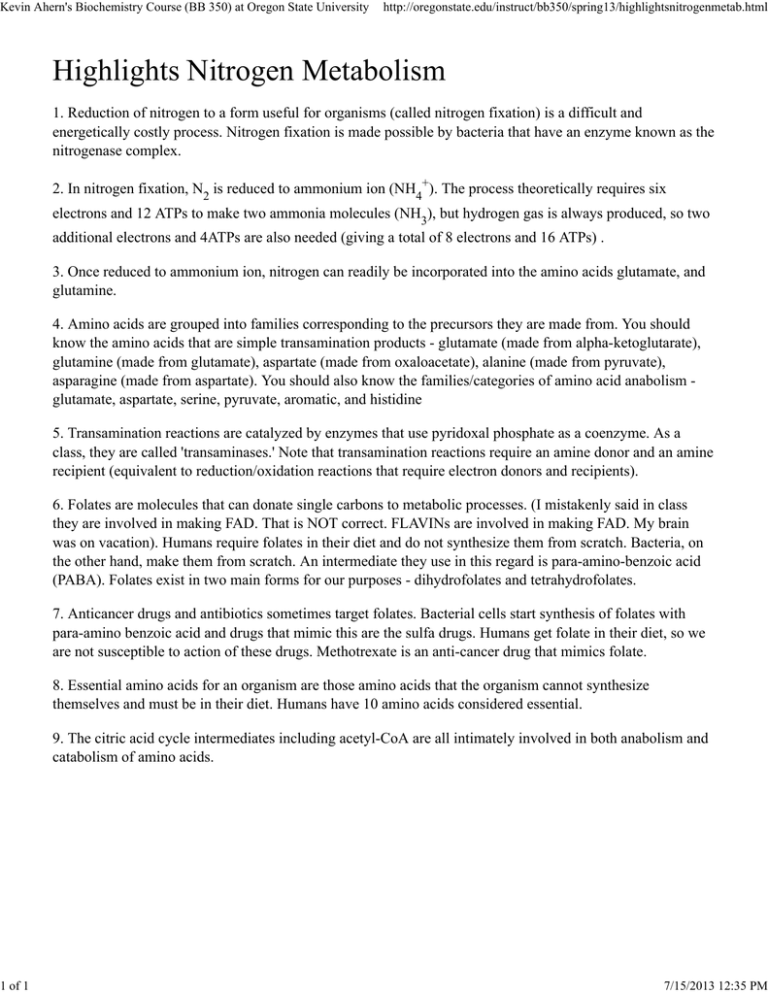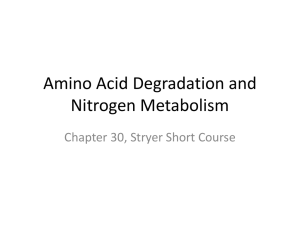Kevin Ahern's Biochemistry Course (BB 350) at Oregon State University
advertisement

Kevin Ahern's Biochemistry Course (BB 350) at Oregon State University http://oregonstate.edu/instruct/bb350/spring13/highlightsnitrogenmetab.html Highlights Nitrogen Metabolism 1. Reduction of nitrogen to a form useful for organisms (called nitrogen fixation) is a difficult and energetically costly process. Nitrogen fixation is made possible by bacteria that have an enzyme known as the nitrogenase complex. 2. In nitrogen fixation, N2 is reduced to ammonium ion (NH4+). The process theoretically requires six electrons and 12 ATPs to make two ammonia molecules (NH3), but hydrogen gas is always produced, so two additional electrons and 4ATPs are also needed (giving a total of 8 electrons and 16 ATPs) . 3. Once reduced to ammonium ion, nitrogen can readily be incorporated into the amino acids glutamate, and glutamine. 4. Amino acids are grouped into families corresponding to the precursors they are made from. You should know the amino acids that are simple transamination products - glutamate (made from alpha-ketoglutarate), glutamine (made from glutamate), aspartate (made from oxaloacetate), alanine (made from pyruvate), asparagine (made from aspartate). You should also know the families/categories of amino acid anabolism glutamate, aspartate, serine, pyruvate, aromatic, and histidine 5. Transamination reactions are catalyzed by enzymes that use pyridoxal phosphate as a coenzyme. As a class, they are called 'transaminases.' Note that transamination reactions require an amine donor and an amine recipient (equivalent to reduction/oxidation reactions that require electron donors and recipients). 6. Folates are molecules that can donate single carbons to metabolic processes. (I mistakenly said in class they are involved in making FAD. That is NOT correct. FLAVINs are involved in making FAD. My brain was on vacation). Humans require folates in their diet and do not synthesize them from scratch. Bacteria, on the other hand, make them from scratch. An intermediate they use in this regard is para-amino-benzoic acid (PABA). Folates exist in two main forms for our purposes - dihydrofolates and tetrahydrofolates. 7. Anticancer drugs and antibiotics sometimes target folates. Bacterial cells start synthesis of folates with para-amino benzoic acid and drugs that mimic this are the sulfa drugs. Humans get folate in their diet, so we are not susceptible to action of these drugs. Methotrexate is an anti-cancer drug that mimics folate. 8. Essential amino acids for an organism are those amino acids that the organism cannot synthesize themselves and must be in their diet. Humans have 10 amino acids considered essential. 9. The citric acid cycle intermediates including acetyl-CoA are all intimately involved in both anabolism and catabolism of amino acids. 1 of 1 7/15/2013 12:35 PM






